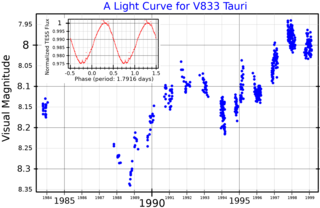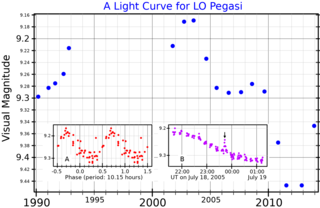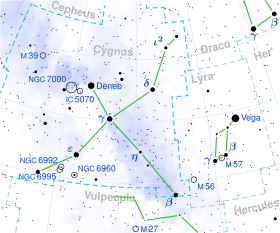
Iota Andromedae is a single star in the northern constellation of Andromeda. It has the Flamsteed designation 17 Andromedae, while Iota Andromedae is the Bayer designation as Latinized from ι Andromedae. This object is visible to the naked eye at night as a faint, blue-white hued star with an apparent visual magnitude of +4.29. Based upon parallax measurements, it is located approximately 500 light years distant from the Sun.

FK Comae Berenices is a variable star that varies in apparent magnitude between 8.14 and 8.33 over a period of 2.4 days. It is the prototype for the FK Comae Berenices class of variable stars. The variability of FK Com stars may be caused by large, cool spots on the rotating surfaces of the stars. This star is thought to be the result of a recent binary merger, resulting in a high rate of both spin and magnetic activity.

HD 74180 is a binary star in the constellation Vela. It is approximately 3,200 light years from Earth. The primary component is a yellow-white F-type supergiant with a mean apparent magnitude of +3.81, with a 10th magnitude companion 37.5 arcseconds distant.

OU Andromedae is a rotationally variable star in the constellation Andromeda. Varying between magnitudes 5.87 and 5.94, it has been classified as an FK Comae Berenices variable, but the classification is still uncertain. It has a spectral classification of G1IIIe, meaning that it is a giant star that shows emission lines in its spectrum. It is also likely in its horizontal branch phase of evolution.
HD 179791 is suspected variable star in the equatorial constellation of Aquila. It is a challenge to see with the naked eye even under good viewing conditions, having an apparent visual magnitude of 6.48. The distance to HD 179791 can be estimated from its annual parallax shift of 5.3 mas, which yields a value of 616 light years. It is moving further from the Earth with a heliocentric radial velocity of +16 km/s. Astrometric measurements of the star show changes in motion that may indicate it is a member of a close binary system.

HD 149989 is a single, variable star in the southern constellation of Ara, located near the western constellation border with Norma. It has the variable star designation V872 Arae, while HD 149989 is the identifier from the Henry Draper Catalogue. This is a dim star near the lower limit of visibility to the naked eye with an apparent visual magnitude that fluctuates around 6.30. It is located at a distance of 167 light years from the Sun based on parallax, and is drifting further away with a radial velocity of 46 km/s.

HD 15082 is a star located roughly 399 light years away in the northern constellation of Andromeda. The star is a Delta Scuti variable and a planetary transit variable. A hot Jupiter type extrasolar planet, named WASP-33b or HD 15082b, orbits this star with an orbital period of 1.22 days. It is the first Delta Scuti variable known to host a planet.

Chi Ceti , is the Bayer designation for a double star in the equatorial constellation of Cetus. They appear to be common proper motion companions, sharing a similar motion through space. The brighter component, HD 11171, is visible to the naked eye with an apparent visual magnitude of 4.66, while the fainter companion, HD 11131, is magnitude 6.75. Both lie at roughly the same distance, with the brighter component lying at an estimated distance of 75.6 light years from the Sun based upon an annual parallax shift of 43.13 mass.
Phi2 Ceti, Latinized from φ2 Ceti), is a star located in the equatorial constellation of Cetus. φ2 Ceti is also known as 19 Cet, and HD 4813. Based upon parallax measurements, it is located about 51 light years away. It has an apparent visual magnitude of +5.19, making it bright enough to be seen with the naked eye. The star is drifting further away with a radial velocity of +8 km/s.
Iota2 Cygni, Latinized from ι2 Cygni and often simply called ι Cygni, is a single star in the constellation Cygnus. It is visible to the naked eye as a white-hued point of light with an apparent visual magnitude of 3.76. Located around 121.3 light-years distant from the Sun based on parallax, it is drifting closer with a radial velocity of −19.5 km/s and is expected to come to within 92 light-years in around 783,000 years.

29 Cygni is a single star in the northern constellation of Cygnus. It is dimly visible to the naked eye as a white-hued star with an apparent visual magnitude of 4.93. The distance to 29 Cyg, as estimated from an annual parallax shift of 24.5 mas, is 133 light years. The star is moving closer to the Earth with a heliocentric radial velocity of −17 km/s. It is a member of the 30–50 million year old Argus Association of co-moving stars.

37 Comae Berenices is a variable star system located around 690 light years away from the Sun in the northern constellation of Coma Berenices. It has the variable star designation LU Comae Berenices. 37 Comae Berenices was a later Flamsteed designation of 13 Canum Venaticorum. This object is visible to the naked eye as a faint, yellow-hued star with a baseline apparent visual magnitude of 4.88. It is drifting closer to the Earth with a heliocentric radial velocity of −14 km/s.
31 Comae Berenices is a yellow giant star in the constellation Coma Berenices. Its apparent magnitude is about 4.9 and slightly variable. It is a rare FK Comae Berenices variable, a variable star that spins rapidly and has large starspots on its surface. It is currently in the Hertzsprung gap and its outer envelope has just begun convection. In 1989 it was given as a spectral standard for the class G0IIIp.
16 Comae Berenices is a single star in the northern constellation of Coma Berenices. 16 Comae Berenices is the Flamsteed designation. It is a member of the Coma Star Cluster and is visible to the naked eye with an apparent visual magnitude of 4.96. Based upon an annual parallax shift of 11.7 mas, it is located about 279 light years away.

28 Monocerotis is a single star in the equatorial constellation of Monoceros. It has an orange-hue and is faintly visible to the naked eye with an apparent visual magnitude of 4.69. The distance to this star is approximately 450 light years based on parallax, and it has an absolute magnitude of −1.00. The star is drifting further away from the Sun with a radial velocity of +26.7 km/s.

HD 111395 is a single, variable star in the northern constellation of Coma Berenices. It has the variable star designation LW Com, short for LW Comae Berenices; HD 111395 is the Henry Draper Catalogue designation. The star has a yellow hue and is just bright enough to be barely visible to the naked eye with an apparent visual magnitude that fluctuates around 6.29. Based upon parallax measurements, it is located at a distance of 55.8 light years from the Sun. The star is drifting closer with a radial velocity of −8.9 km/s. It is a member of the Eta Chamaeleontis stellar kinematic group.

HD 283750, also known as V833 Tauri, is a K-type main-sequence star 57 light-years away from the Sun. The star is much younger than the Sun's at 1 billion years. HD 283750 is similar to the Sun in its concentration of heavy elements.

LQ Hydrae is a single variable star in the equatorial constellation of Hydra. It is sometimes identified as Gl 355 from the Gliese Catalogue; LQ Hydrae is the variable star designation, which is abbreviated LQ Hya. The brightness of the star ranges from an apparent visual magnitude of 7.79 down to 7.86, which is too faint to be readily visible to the naked eye. Based on parallax measurements, this star is located at a distance of 59.6 light years from the Sun. It is drifting further away with a radial velocity of 7.6 km/s.

LO Pegasi is a single star in the northern constellation of Pegasus that has been the subject of numerous scientific studies. LO Pegasi, abbreviated LO Peg, is the variable star designation. It is too faint to be viewed with the naked eye, having an apparent visual magnitude that ranges from 9.04 down to 9.27. Based on parallax measurements, LO Peg is located at a distance of 79 light years from the Sun. It is a member of the young AB Doradus moving group, and is drifting closer with a radial velocity of −23 km/s.

YY Mensae, also known as HD 32918, is a variable star located in the southern circumpolar constellation Mensa. It has an apparent magnitude that fluctuates between 8.6 and 8.9, which is within the visibility of binoculars. Based on parallax measurements from Gaia DR3, it is estimated to be 715 light years distant. It appears to be approaching the Solar System with a heliocentric radial velocity of −8.5 km/s.
















